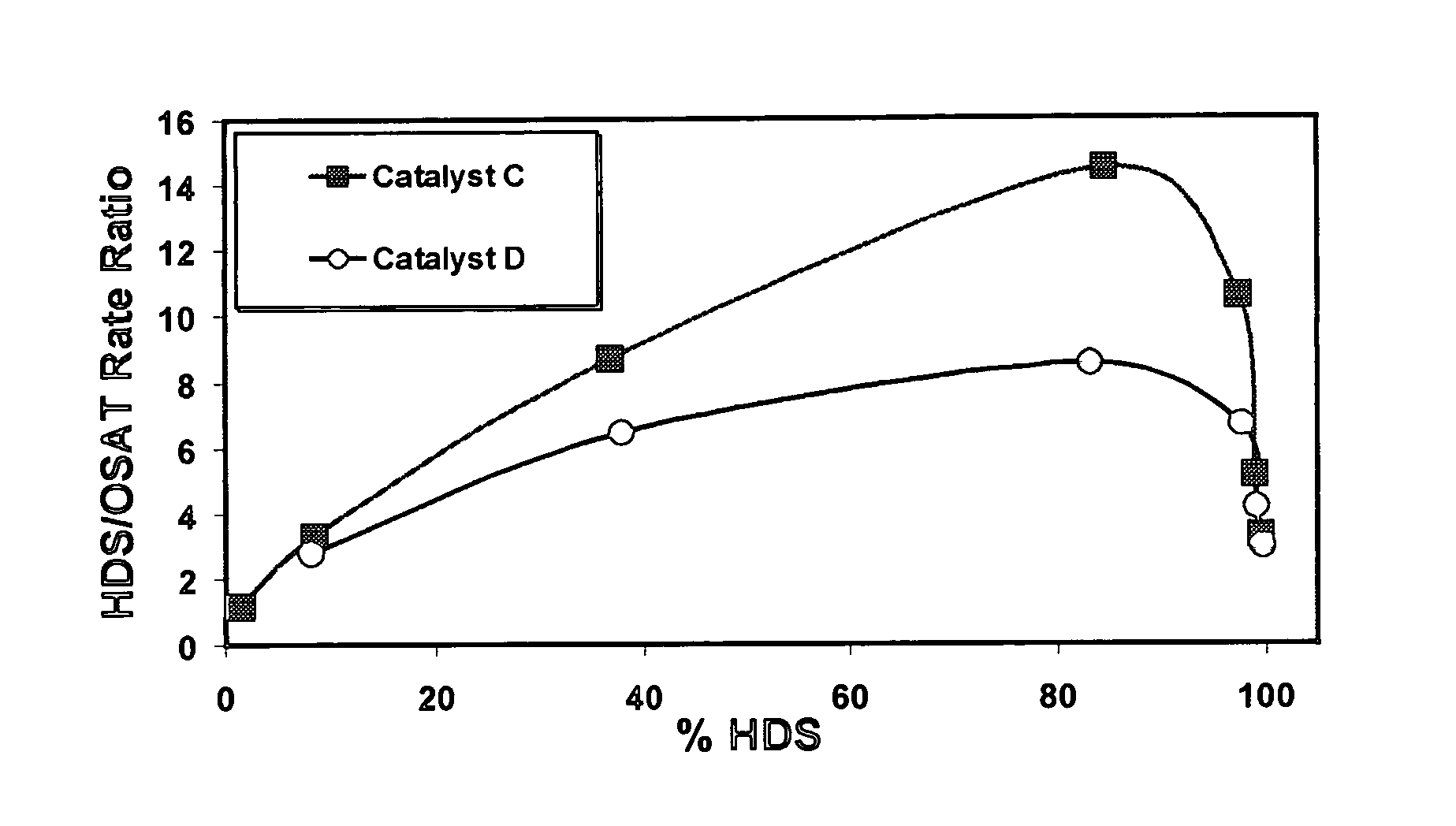Selective hydrodesulfurization catalyst
- Summary
- Abstract
- Description
- Claims
- Application Information
AI Technical Summary
Benefits of technology
Problems solved by technology
Method used
Image
Examples
example 1
Catalyst Support Preparation
[0068] A mixture was prepared for extrusion by blending about 90 wt. % of MCM-41 crystal that had been calcined, and 10 wt. % SiO2 equivalent of Dow Corning 6-2230 silicone resin (which had been milled to <30 US mesh), in an Eirich mixer for 5 minutes. Water was added to adjust the solids in the mixture to 42 wt. % and 1.5 wt. % polyvinylalcohol was added as an extrusion aid. This mixture was allowed to ball up into 1 / 16″ to ⅛″ spheres prior to extrusion. The extrusion was run with a 1 / 16″ cylinder die plate and at 11.5 amps. During the extrusion, steam was given off and there was noticeable condensation on the outside surface of the die. The extrudate was dried at 250° F. overnight and was then calcined in nitrogen followed by air. The compressive strength after calcination was measured as 54 lb / in.
example 2
Support Acidity Measurements
[0069] Potential catalyst support samples were evaluated for acidity in accordance with a 2-methyl-2 pentene reaction test. As discussed, skeletal isomerization rates generally increase with relative increasing acid strength, and consequently, the ratio of methyl group migration rate to double bond shift rate (the “Rate Ratio” herein) increases with increasing acid strength. The equilibrium value for the ratio of (cis / trans)3-methylpent-2-ene (3MP2) to (cis / trans)4-methylpent-2-ene (4MP2) is near 4.4. It should be noted that Support A, which is an amorphous silica-alumina, has an acidity on the alpha scale of about 1, corresponding to a Rate Ratio value of approximately 3.85.
[0070] The tests were conducted under the following conditions: 250° C. temperature, 1.0 atm. pressure, 1.0 g catalyst, 2.0 hours on feed, with a feed comprising 11.2 ml / min. of 2-methyl-2 pentene and 150 m / min. of helium.
[0071] Support A comprised 87 wt. % silica and 13 wt. % alu...
example 3
Catalyst Acidity Measurements
[0074] Catalyst A comprised Support D (MCM-41 containing 99.7 wt. % silica, 0.3 wt. % alumina) with approximately 7.4 wt. % CoO and 28.5 wt. % MoO3. Catalyst B comprised Support C (MCM-41 containing 90.7 wt. % silica and 9.3 wt. % alumina) with approximately 7.4 wt. % CoO and 28.5 wt. % MoO3. Catalysts were evaluated in the oxide form. Test results are set out in the following table.
FeedConversionCT4MP2 rateCT3MP2 rateRateCatalyst(Mol. %)(Mol / hr / g × 103)(Mol / hr / g × 103)RatioA39.02.790.950.34B44.43.412.040.60
[0075] Catalyst A, comprising MCM-41 of the highest silica content compared to the other MCM-41 catalyst, has the lowest acidity. Catalyst B, which contains some alumina, has an appreciably higher acid strength, but is still low acidity as that term is used herein. Although the measured acidities for both of these catalysts are considered low, the inherent higher acidity of the support used to prepare Catalyst B results in higher acidity in the fi...
PUM
 Login to View More
Login to View More Abstract
Description
Claims
Application Information
 Login to View More
Login to View More - R&D
- Intellectual Property
- Life Sciences
- Materials
- Tech Scout
- Unparalleled Data Quality
- Higher Quality Content
- 60% Fewer Hallucinations
Browse by: Latest US Patents, China's latest patents, Technical Efficacy Thesaurus, Application Domain, Technology Topic, Popular Technical Reports.
© 2025 PatSnap. All rights reserved.Legal|Privacy policy|Modern Slavery Act Transparency Statement|Sitemap|About US| Contact US: help@patsnap.com

